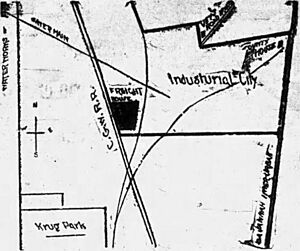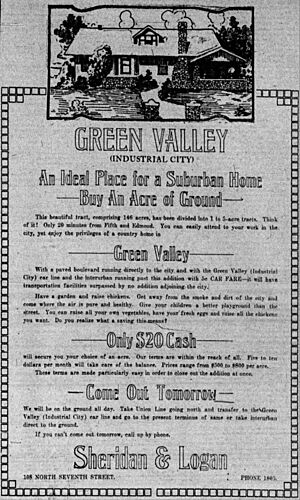Industrial City, Missouri facts for kids
Industrial City, also called Green Valley, was once a small town in Buchanan County, Missouri. Today, it is a neighborhood within the larger city of St. Joseph.
In the early 1900s, people first planned Industrial City to be a place for factories. But not many companies wanted to build there. So, it became a neighborhood for homes instead, and people started calling it Green Valley. The area grew, getting its own school, post office, bank, and churches. In 1958, Green Valley officially joined St. Joseph and became one of its neighborhoods.
Contents
The Story of Industrial City
In 1907, ten important business people from St. Joseph had a big idea. They wanted to create a large area for factories outside of St. Joseph. This new area was planned to be northeast of Krug Park. It was located between the road to Savannah and the Chicago Great Western Railway. They named this planned factory area "The Industrial City."
The plans moved forward in June 1907. The new Industrial Development Company bought 200 acres of land. Besides building factories, the investors also wanted to extend the streetcar service. This would connect Krug Park to the new industrial area. The streetcar line cost about $12,000 to build. It officially opened on October 1, 1908.
Even with public transport, no businesses had moved to the area by July 1910. A shoe machinery company thought about building a factory there. But they decided not to because there was no easy access to gas, water, or power. A foundry company also had similar plans but chose to move to St. Joseph instead.
Green Valley: A Place to Live
Since the factory idea didn't work out, a new company stepped in. In April 1911, the Green Valley Investment Company bought 146 acres from the Industrial Development Company. Their goal was to create a large neighborhood for homes. They called this new area "Green Valley." By September 1912, about 150 children lived there. Local families started asking for a new school. In September 1915, construction began on the Green Valley School building. It cost around $6,500 to build.
In January 1916, the first Sunday school service was held in Hurst Hall. In October 1922, work started on the Community Presbyterian Church. This church was built with hollow tile at the corner of Savannah Road. Around that time, the Reorganized Church of Jesus Christ of Latter Day Saints also built their Fifth Church in the settlement.
In March 1924, the area got its own post office. A local businessman, F. L. Taulman, became the postmaster. With the post office, the town officially became known as Industrial City. It stopped using "Green Valley" because other towns already had that name. Later that year, the Growers' State Bank opened in the town.
More People, More Growth
During the 1920s, more and more people moved to Industrial City. This put pressure on the local services. By February 1925, Green Valley School had 80 children in four grades. Another 40 children were taken by bus to a nearby school. Plans were made to build a new, bigger school. It would have six rooms, a gym, a stage, and showers. This new school cost $40,000. It was finished in early 1926. The old school building was taken down later that year.
In April 1926, the St. Joseph Water Company announced plans to lay water mains under the town. This would connect St. Joseph to a nearby country club. Work also began on Blackwell Road later that year. This road connected the east and west Savannah roads through Industrial City.
In 1958, Industrial City stopped being its own separate town. It officially became a neighborhood of St. Joseph.
Where Was Industrial City?
Industrial City was located near Blacksnake Creek. This stream naturally flowed into the Blacksnake sewer system.
In the 1950s, the town's two main living areas were separated by the railway tracks.
In 1958, Industrial City had between 1,200 and 1,500 people living there.



